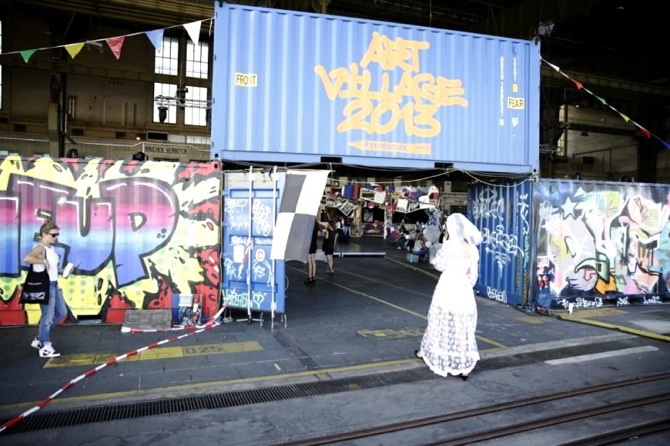

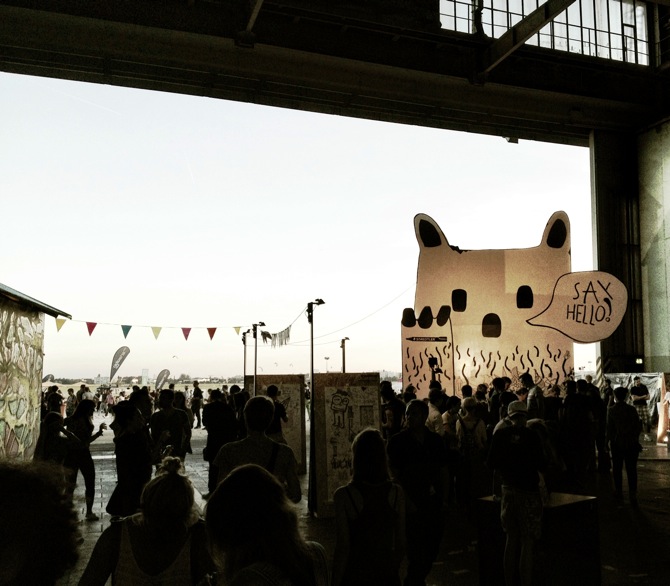
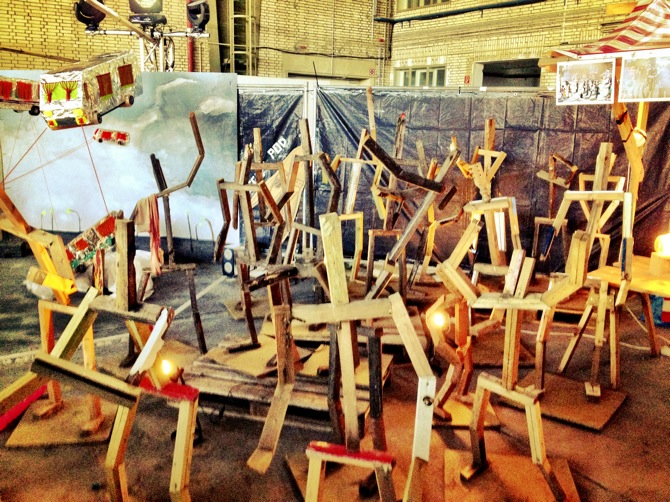

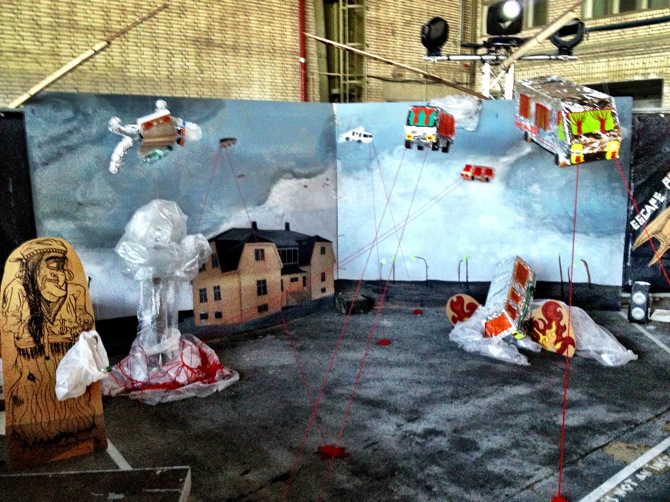

all images: Art Village 2013 at Berlin Festival, courtesy the artists, photos by Anneli Botz
Berlin Festival is not only known for its carefully selected choice of music but also for its position as a melting pot of creativity. Over the years, the Festival’s organizers have developed a smart understanding of how closely good music and art are linked together. Therefore the wide area of Berlin’s old airport Tempelhof did not only offer the witnessing of breathtaking acts such as Björk, Blur and The Pet Shop Boys, but also the chance to participate in the Festivals biggest Art Village so far. On a widespread space area curator Jan ‘Yaneq’ Kage gathered various artists to create a space for performances, poetry slams, DIY booths and general inspiration. As a colourful and versatile installation the area had everything a real village has to offer: A village pub, a marketplace for dances, a circus tent, an outdoor pool and even a church with the meaningful name “Church of Phonk”. To give a better understanding of what the story behind the Art Village is all about, we spoke to Jan Kage himself and got some insightful answers that show how much of a stand the village actually takes in a general art historian discourse.
Anneli Botz: At this year’s Art Village at Berlin Festival you gathered a high number of artists, various genre positions and different settings. How was your original idea for this Art Village different to prior ones and after what concept did the selection of artists progress?
Jan Kage: The basic idea was to take the title “Art Village” literally and to build a real village. What does every village in Germany sport? A pub and a church. So the Bar-Kowski – as an homage to Charles Bukowski – and the holy Church of Phonk became the cornerstones. The dance-quartett Quiet In The Corner who won the special prize last year hostet their Tanzplatz stage and the Poetry Salon hosted by Germanys longest – timewise – poetry slammer Wolf Hogekamp were integral, too. The selection was as elective as it can be from urban art to contemporary and back.
Anneli Botz: The “Church of Phonk” was one of the central pieces of this year’s Art Village. What was the idea behind it, how were you personally included in this piece of art and how did it come together?
Anneli Botz: The “Church of Phonk” was one of the central pieces of this year’s Art Village. What was the idea behind it, how were you personally included in this piece of art and how did it come together?
Jan Kage: The Church of Phonk is the church for the agnostic. In a world in which nobody believes in gods anymore the arts and music are the last existing room for transcendence and spirituality. Ever danced for hours with some hundred people and lifted your arms simultaneously with the other one the snare rolled? That's spiritual. I scripted the church some two years ago as a multimedia installation for 10 artists and this year we finally realized it.
Anneli Botz: How much are music, art and spirituality linked together in your point of view? And on the other hand: How much can religion and dogma be an obstacle in the creative and spiritual process of letting loose?
Jan Kage: Religion and then dogma are formations in time and space of the eternal spiritual truths that really make us man. From the Incas to Chinese, from African kingdoms and tribes to the Vikings, from Saudis to Canadians: Within the last 70.000 years all groups came up with the same basic rules: Don't kill in your community, don't steal etc. So these truths must be bigger than, let's say, Protestantism or whatever timely formation of this whole thing. Dogmas are just manifestations. The Church of Phonk does not manifest. It is free floating. Just like music. By the way: Philosophy and all forms of art have the same source as these religious formations. The Church of Phonk binds the agnostic schools.
Anneli Botz: When I first heard the name “Church of Phonk” I instantly felt reminded of Christoph Schlingensiefs’ “Church of Fear” and various other occasions where he used Christian traditions and rituals in his performances and pieces. Although functioning in a lot more subtlety provocative way than Schlingensief’s projects, the “Church of Phonk” also seems to follow up on post-modern ways of parodying and pointing out structures of dogma, religion and authority while putting the church itself in a different setting of music, creativity, fun and free thought.
Jan Kage: I love Christoph Schlingensief. And it's a shame he died so early. He surely left a gap. Other than the Church of Fear, though, the Church of Phonk has nothing to do with Christianity nor with any other religion – beside the same source of spirituality we all draw from. It is not about fear, sin and dealing with catholic or protestant traditions. We just don't care about that and go way further back. Back to the beginning of man. When the first sisters and brothers started forming words, started to draw bulls and then had to put a name to it while some other sister and a brother beat some bones together and started shouting to it. Drawing, speaking and music – they all go back to that moment in southern Africa when man became man. Essentially he became man through inventing the arts and thus spirituality uplifting himself. And to answer your question: Yes, of course this is a post-modern practice.
Anneli Botz: Another thing I found compelling was the dancing circle in the centre of the village, which made for a vibrant, almost iconic epicentre of the whole installation. How did you feel about that space, there any performance in particular that you liked and how was the general reception?
Jan Kage: I agree, the Tanzplatz was a great contribution to the whole Art Village because it brought life and movement into the by nature static arrangement of installations and scultpture. And the people loved it. Every hour they gathered by the hundreds to watch our hosts QITC and their friends dance and perform. So, we are surely going to bring them back next year. They also won the special art prize for their curating of the stage.
Jan Kage: Religion and then dogma are formations in time and space of the eternal spiritual truths that really make us man. From the Incas to Chinese, from African kingdoms and tribes to the Vikings, from Saudis to Canadians: Within the last 70.000 years all groups came up with the same basic rules: Don't kill in your community, don't steal etc. So these truths must be bigger than, let's say, Protestantism or whatever timely formation of this whole thing. Dogmas are just manifestations. The Church of Phonk does not manifest. It is free floating. Just like music. By the way: Philosophy and all forms of art have the same source as these religious formations. The Church of Phonk binds the agnostic schools.
Anneli Botz: When I first heard the name “Church of Phonk” I instantly felt reminded of Christoph Schlingensiefs’ “Church of Fear” and various other occasions where he used Christian traditions and rituals in his performances and pieces. Although functioning in a lot more subtlety provocative way than Schlingensief’s projects, the “Church of Phonk” also seems to follow up on post-modern ways of parodying and pointing out structures of dogma, religion and authority while putting the church itself in a different setting of music, creativity, fun and free thought.
Jan Kage: I love Christoph Schlingensief. And it's a shame he died so early. He surely left a gap. Other than the Church of Fear, though, the Church of Phonk has nothing to do with Christianity nor with any other religion – beside the same source of spirituality we all draw from. It is not about fear, sin and dealing with catholic or protestant traditions. We just don't care about that and go way further back. Back to the beginning of man. When the first sisters and brothers started forming words, started to draw bulls and then had to put a name to it while some other sister and a brother beat some bones together and started shouting to it. Drawing, speaking and music – they all go back to that moment in southern Africa when man became man. Essentially he became man through inventing the arts and thus spirituality uplifting himself. And to answer your question: Yes, of course this is a post-modern practice.
Anneli Botz: Another thing I found compelling was the dancing circle in the centre of the village, which made for a vibrant, almost iconic epicentre of the whole installation. How did you feel about that space, there any performance in particular that you liked and how was the general reception?
Jan Kage: I agree, the Tanzplatz was a great contribution to the whole Art Village because it brought life and movement into the by nature static arrangement of installations and scultpture. And the people loved it. Every hour they gathered by the hundreds to watch our hosts QITC and their friends dance and perform. So, we are surely going to bring them back next year. They also won the special art prize for their curating of the stage.
Anneli Botz: Looking back at this year’s Art Village at the Berlin Festival: Have your expectations been fulfilled, how was the general response and what are your hopes for next year?
Jan Kage: Oh, yes, I am more than happy – and exhausted. I highly enjoyed the Art Vilage and was there all of the time. The response was overwhelming. Everybody seemed to love it. Next year? We will build a postmodern mega city.
Jan Kage: Oh, yes, I am more than happy – and exhausted. I highly enjoyed the Art Vilage and was there all of the time. The response was overwhelming. Everybody seemed to love it. Next year? We will build a postmodern mega city.



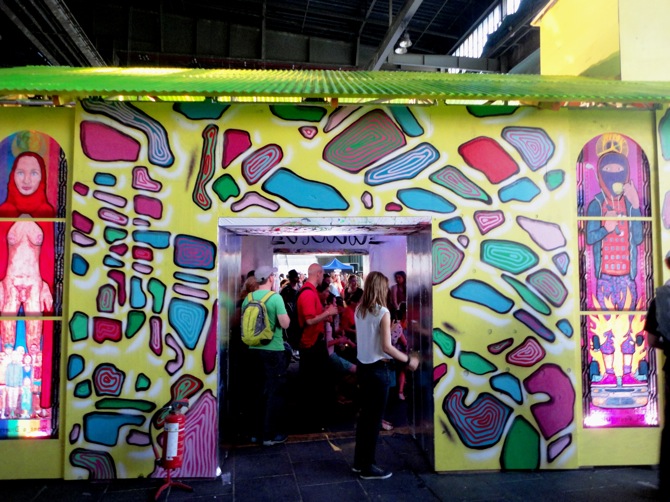 all images: Art Village 2013 at Berlin Festival, courtesy the artists, photos by Anneli Botz
all images: Art Village 2013 at Berlin Festival, courtesy the artists, photos by Anneli Botz 